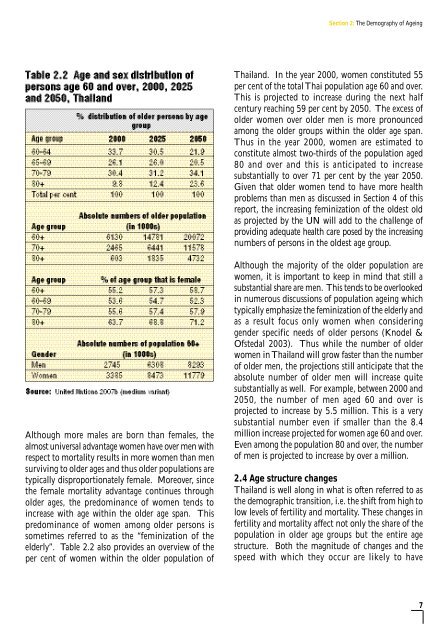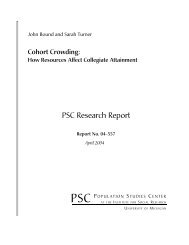Population Ageing and the Well-Being of Older Persons in Thailand ...
Population Ageing and the Well-Being of Older Persons in Thailand ...
Population Ageing and the Well-Being of Older Persons in Thailand ...
You also want an ePaper? Increase the reach of your titles
YUMPU automatically turns print PDFs into web optimized ePapers that Google loves.
Section 2: The Demography <strong>of</strong> <strong>Age<strong>in</strong>g</strong><br />
Thail<strong>and</strong>. In <strong>the</strong> year 2000, women constituted 55<br />
per cent <strong>of</strong> <strong>the</strong> total Thai population age 60 <strong>and</strong> over.<br />
This is projected to <strong>in</strong>crease dur<strong>in</strong>g <strong>the</strong> next half<br />
century reach<strong>in</strong>g 59 per cent by 2050. The excess <strong>of</strong><br />
older women over older men is more pronounced<br />
among <strong>the</strong> older groups with<strong>in</strong> <strong>the</strong> older age span.<br />
Thus <strong>in</strong> <strong>the</strong> year 2000, women are estimated to<br />
constitute almost two-thirds <strong>of</strong> <strong>the</strong> population aged<br />
80 <strong>and</strong> over <strong>and</strong> this is anticipated to <strong>in</strong>crease<br />
substantially to over 71 per cent by <strong>the</strong> year 2050.<br />
Given that older women tend to have more health<br />
problems than men as discussed <strong>in</strong> Section 4 <strong>of</strong> this<br />
report, <strong>the</strong> <strong>in</strong>creas<strong>in</strong>g fem<strong>in</strong>ization <strong>of</strong> <strong>the</strong> oldest old<br />
as projected by <strong>the</strong> UN will add to <strong>the</strong> challenge <strong>of</strong><br />
provid<strong>in</strong>g adequate health care posed by <strong>the</strong> <strong>in</strong>creas<strong>in</strong>g<br />
numbers <strong>of</strong> persons <strong>in</strong> <strong>the</strong> oldest age group.<br />
Although more males are born than females, <strong>the</strong><br />
almost universal advantage women have over men with<br />
respect to mortality results <strong>in</strong> more women than men<br />
surviv<strong>in</strong>g to older ages <strong>and</strong> thus older populations are<br />
typically disproportionately female. Moreover, s<strong>in</strong>ce<br />
<strong>the</strong> female mortality advantage cont<strong>in</strong>ues through<br />
older ages, <strong>the</strong> predom<strong>in</strong>ance <strong>of</strong> women tends to<br />
<strong>in</strong>crease with age with<strong>in</strong> <strong>the</strong> older age span. This<br />
predom<strong>in</strong>ance <strong>of</strong> women among older persons is<br />
sometimes referred to as <strong>the</strong> “fem<strong>in</strong>ization <strong>of</strong> <strong>the</strong><br />
elderly”. Table 2.2 also provides an overview <strong>of</strong> <strong>the</strong><br />
per cent <strong>of</strong> women with<strong>in</strong> <strong>the</strong> older population <strong>of</strong><br />
Although <strong>the</strong> majority <strong>of</strong> <strong>the</strong> older population are<br />
women, it is important to keep <strong>in</strong> m<strong>in</strong>d that still a<br />
substantial share are men. This tends to be overlooked<br />
<strong>in</strong> numerous discussions <strong>of</strong> population age<strong>in</strong>g which<br />
typically emphasize <strong>the</strong> fem<strong>in</strong>ization <strong>of</strong> <strong>the</strong> elderly <strong>and</strong><br />
as a result focus only women when consider<strong>in</strong>g<br />
gender specific needs <strong>of</strong> older persons (Knodel &<br />
Ofstedal 2003). Thus while <strong>the</strong> number <strong>of</strong> older<br />
women <strong>in</strong> Thail<strong>and</strong> will grow faster than <strong>the</strong> number<br />
<strong>of</strong> older men, <strong>the</strong> projections still anticipate that <strong>the</strong><br />
absolute number <strong>of</strong> older men will <strong>in</strong>crease quite<br />
substantially as well. For example, between 2000 <strong>and</strong><br />
2050, <strong>the</strong> number <strong>of</strong> men aged 60 <strong>and</strong> over is<br />
projected to <strong>in</strong>crease by 5.5 million. This is a very<br />
substantial number even if smaller than <strong>the</strong> 8.4<br />
million <strong>in</strong>crease projected for women age 60 <strong>and</strong> over.<br />
Even among <strong>the</strong> population 80 <strong>and</strong> over, <strong>the</strong> number<br />
<strong>of</strong> men is projected to <strong>in</strong>crease by over a million.<br />
2.4 Age structure changes<br />
Thail<strong>and</strong> is well along <strong>in</strong> what is <strong>of</strong>ten referred to as<br />
<strong>the</strong> demographic transition, i.e. <strong>the</strong> shift from high to<br />
low levels <strong>of</strong> fertility <strong>and</strong> mortality. These changes <strong>in</strong><br />
fertility <strong>and</strong> mortality affect not only <strong>the</strong> share <strong>of</strong> <strong>the</strong><br />
population <strong>in</strong> older age groups but <strong>the</strong> entire age<br />
structure. Both <strong>the</strong> magnitude <strong>of</strong> changes <strong>and</strong> <strong>the</strong><br />
speed with which <strong>the</strong>y occur are likely to have<br />
7















